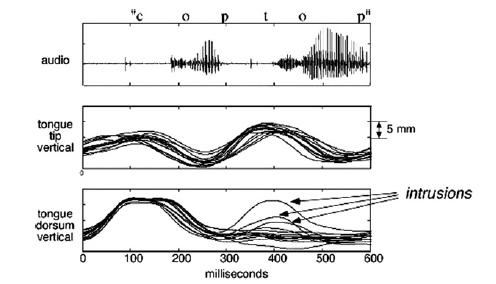Actions, Signals and Symbols
K.S. Lashley began his famous article "The problem of serial order in behavior" (from Cerebral Mechanisms in Behavior: the Hixon Symposium, 1951) like this:
Our discussion so far has dealt chiefly with the conditions of input and of immediate switching in the nervous mechanism, without explicit consideration of what is already going on within the system.
My principal thesis today will be that the input is never into a quiescent or static system, but always into a system which is already actively excited and organized. In the intact organism, behavior is the result of interaction of this background of excitation with input from any designated stimulus. Only when we can state the general characteristics of this background of excitation, can we understand the effects of a given input.
The unpronounceable Cree Indian word "kekawewecbetushekamikowanowow" is analyzed by Chamberlain (7) into the verbal root, tusheka, "to remain," and the various particles which modify it as follows...
This was was the first article that Eric Lenneberg had us read in a seminar that I took my freshman year in college. At least, it's the first article whose content I remember.
Like most others, I soon turned away from the "nervous mechanism" and the "background of [neural] excitation", at least when it came to thinking about serial order in speech. Vicki Fromkin and others at that time were showing us all the exciting things you could learn by treating speech errors as digital edits in a symbol string. On the face of it, that's what they are: consider the Reverend Spooner's famous admonition to an errant undergraduate, "you have tasted the whole worm" in place of "you have wasted the whole term".
But more recently, Louis Goldstein, Dani Byrd and others have shown that speech errors are also often gradient modulations and intrusions in a gestural trajectory:
Fig. 1. Overlay of 14 successive repetitions of the phrase cop top by a single speaker (JP). Top panel shows audio signal from a single repetition. Middle panel shows overlaid time functions of the vertical position of the receiver placed on the tongue tip. Bottom panel shows overlaid time functions of the vertical position of the receiver placed on the tongue dorsum. Line-up is point of zero velocity of vertical tongue dorsum movement.
[From L. Goldstein et al., "Dynamic action units slip in speech production errors", Cognition 103 (2007) 386–412]
This is one of many hints that the combinatoric aspects of speech and language are overlaid on emergent properties of the motor system.
This may be true not only phylogenetically -- in the evolutionary history of our species -- and ontogenetically -- in the developmental history of individuals -- but also everyday use of language.
Michael Ullman and others claim, on the basis of converging evidence, that "idiosyncratic knowledge (e.g., in irregular past tense formation; bring–brought) is stored in a mental lexicon that depends on the temporal-lobe-based declarative memory system that also underlies conceptual knowledge", while "rule-governed combination (e.g., in regular past tenses; walk + -ed) takes place in a mental grammar that relies on the frontal/basal-ganglia-based procedural memory system, which also underlies motor skills such as how to use a hammer".
Adult-onset patients with temporal neocortical damage, but relatively intact frontal/basal-ganglia procedural structures (e.g., in posterior aphasia, semantic dementia, or Alzheimer's disease) show relative sparing of motor and other procedural functions, but impairments in processing previously learned (i.e., established) semantic and lexical knowledge, including in the production of irregular and novel irregular past tense forms (e.g., dig–dug, spling–splang) ...
In contrast, adult-onset patients with frontal and/or basal-ganglia lesions, but relative sparing of temporal lobe structures (e.g., in anterior aphasia, non-demented Parkinson's disease, and Huntington's disease), often show impairments with motor skills, knowledge of tool use, naming tools and other manipulated objects, syntactic processing, and the production of consistent and novel regulars (e.g., slip–slipped, splim–splimmed) ... Moreover, patients with Huntington's disease (whose particular basal ganglia degeneration results in unsuppressed or “hyper” behaviors, such as hyperkinesia) often add additional affixes (walkeded, blickeded, broughted), whereas patients with Parkinson's disease (whose basal ganglia degeneration results in suppressed or “hypo” behaviors, such as hypokinesia) do not make these errors.
[...]
We found that [Tourette's Syndrome] children were significantly faster than typically developing control children in producing rule-governed past tenses (slip–slipped, plim–plimmed, bring–bringed) but not irregular and other unpredictable past tenses (bring–brought, splim–splam). They were also faster than controls in naming pictures of manipulated (hammer) but not non-manipulated (elephant) items. These data were not explained by a wide range of potentially confounding subject- and item-level factors. The results suggest that the processing of procedurally based knowledge, both of grammar and of manipulated objects, is particularly speeded in TS. The frontal/basal-ganglia abnormalities may thus lead not only to tics, but also to a wider range of rapid behaviors, including the cognitive processing of rule-governed forms in language and other types of procedural knowledge.
[From M. Walenski, S. Mostofsky and M. Ullman, "Speeded processing of grammar and tool knowledge in Tourette's syndrome", Neuropsychologia 45(11) 2447-2460 (2007)]
There's a connection here to the mathematics as well as to the neurology of grammar.
